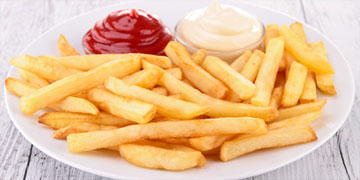Fats, like carbohydrates, are essential energy carriers. However they do contain more energy than carbohydrates (9 kcal compared to 4 kcal per gram) and are therefore the body’s main source energy. Recent research shows fat has also non-caloric functions:
- Fat that is stored underneath our skin has energy reserve functions. It serves as a storage system and reserve supply of energy.
- Fat serves as an insulation material to allow body heat to be conserved.
- Fat protects delicate internal organs from physical damage.
- Myelin, the substance that covers and protects nerves, is also a kind of fat.
- Our cell membranes require several types of lipids.
- Fat-soluble vitamins (A, D, E and K) are needed to maintain good health. Our body needs at least 25 gram of fat per day to absorb the necessary amounts of these vitamins.
Composition

Fats are basically composed of carbon (C), hydrogen (H) and oxygen (O). Certain fats also contain small amounts of phosphorus (P) and nitrogen (N). Contrary to proteins, the chemical structure of fats is relatively simple. There are many different kinds of fats, but each is a variation on the same chemical structure: they are all derivatives of fatty acids and glycerol. The chemical structure of fat looks a bit like a flagpole (glycerol) from which three flags (fatty acids) hang. One of the simplest fatty acids is acetic acid, a component of vinegar. Fats that are an important source of food for our body can be composed from approximately 20 fatty acids and can be divided into saturated and unsaturated fats depending on their composition. Saturated fats are solid at room temperature and contain high levels of saturated fatty acids. Unsaturated fats (or oils) are liquid at room temperature and contain high levels of unsaturated fatty acids and less than 30 percent saturated fatty acids.
ALA, EPA and DHA, Omega-3 and Omega-6
ALA, EPA and DHA are abbreviations of the chemical names of polyunsaturated fatty acids. ALA stands for Alpha-Linolenic Acid. It comes primarily from plant sources (e.g. soy oil, olive oil) and nuts (especially walnuts) and seeds. EPA stands for Eicosapentaenoic Acid and DHA for Docosahexaenoic Acid.
The latter are mainly found in fatty fish such as herring, mackerel, salmon, trout, eel and sardines. ALA, EPA and DHA are all omega-3 fatty acids. Examples of omega-6 fatty acids are linoleic acid and arachidonic acid (in peanut oil). Omega-3 and omega-6 fatty acids are essential fatty acids because the body requires them for good health however the body cannot manufacture them on its own and therefore they must be obtained by food sources.
Trans fat
Unsaturated fatty acids can be divided into cis- and trans-fatty acids. If we look at the chemical structure of an unsaturated fatty acid, we see that the hydrogen atoms can be bonded to the carbon atoms in two different ways: they are either arranged on the same side (cis) or on opposite sides (trans). Most of the naturally unsaturated fatty acids are of the cis-type. Trans fatty acids naturally occur in small amounts in the fat of ruminants (cow, buffalo, goat, sheep), hence the 2 to 5 percent trans-fatty acids in butter.
Already in the 1980s, food experts and cardiologists suspected that partially hydrogenated fats increased the risk of cardiovascular disease. The composition of margarines changed over time and more plant oils were added. To convert the liquid oil to a spreadable fat, the oils are heated up in a container and hydrogen gas is applied (hydrogenation). During the hydrogenation process cis double bonds are converted into trans double bonds, thus increased levels of trans fatty acids with a negative impact on cholesterol levels. They increase the ‘bad’ cholesterol while lowering the ‘good’ cholesterol. Trans fatty acids also increase blood insulin levels, which increases the risk of Diabetes Type II.
There is no official DRI (Dietary Reference Intake), but the American Food and Nutrition Board recommend as low as possible. The safest level of trans fat is zero (0). The World Health Organization (WHO) recommendation is that the intake of trans fat should not exceed 1 percent of the total daily intake of calories. They advise consumers not to eat more than 2,0 – 2,5 gram of trans fatty acids a day. Beware that an average meal at a fast-food restaurant easily accounts for minimum 7 gram of trans fatty acids! Frying fat used for the production of cookies, solid frying fat and solid margarines often account for even higher amounts of trans-fatty acids.
Fat Structure Overview
The overview below shows the composition of fatty acids.
Saturated fat
Structural formula of saturated fat.
C18H36O2
Polyunsaturated fatty acid
Structural formula of polyunsaturated fatty acid.
C18H36O2
Triglycerides
Origin of a triglyceride.